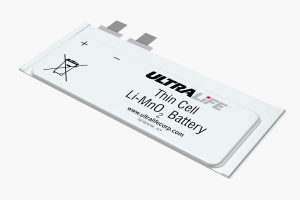Power in a connected world

According to Forrester research, over 85% of companies will be implementing or planning Internet of Things (IoT) deployments by the end of 2019. The fundamental goal of the IoT is to streamline processes and improve efficiency, and powering these devices is key. Here, J.D. DiGiacomandrea, applications manager at Ultralife Corporation, explains how Ultralife Thin Cell technology will help design engineers create the next generation of connected devices.
When the first networked computer system was developed in 1969, it didn’t initially prove successful. The first transmission between nodes on the ARPANET network crashed, with only two of the five letters of the word ‘login’ being successfully sent. But this transmission set in motion a chain of technological advancements and events that would go on to reshape the world.
Today’s fast connection speeds mean a person can not only transmit the word ‘login’ half way around the world but can remotely login to a connected computer. Rather, the modern challenge to improve how devices wirelessly communicate with, control and command one another with minimal human interaction – but powering these devices will remain a prevalent issue.
For example, if you are wirelessly networking industrial machinery, motors and robots with a manufacturing execution system (MES) and a sensor loses power, the performance data of the connected system cannot be collected. This can negatively affect operations, such as delivering product to schedule.
Unfortunately, there is no silver bullet to fixing connectivity challenges. The solution will depend on the type of communication technology that the device uses, such as radio frequency (RF) or Wi-Fi. As an IoT battery manufacturer, Ultralife Corporation has seen that RF that can present some of the more interesting design challenges.
Slim profile power
Historically, the role of RF in industrial settings has predominately been in asset tracking through RF identification (RFID) tags. These tags transmit their movement and location data and come in two variants: passive and active. Passive tags contain no battery but are powered by the RF energy transmitted by battery-powered RFID readers, whereas active tags contain batteries and continuously broadcast information to be monitored.

J.D. DiGiacomandrea
Modern sensors that communicate using RF bursts share some common design considerations with RFID tags. Much like the tags, these sensors are often designed to be discrete and compact but require an in-built power supply to ensure consistent transmission. Therefore, these devices need a compact battery with a high energy density, high pulse power capabilities and long performance life — a balancing act that poses a challenge for many battery manufacturers.
It is for this reason that Ultralife Corporation developed its Thin Cell technology. Thin Cell batteries can be manufactured as thin as 0.7mm and as small as 20mm x 20mm, making them the ideal choice for products with a discrete profile. In addition to this, the cells have a high volumetric and gravimetric energy density that performs markedly better than the best lithium coin cells.
The Thin Cell’s typical energy density is around 500 Wh/l and 400 Wh/Kg, compared to 300 Wh/l and 260 Wh/kg in lithium coin-cell counterparts. For design engineers, this means a product that can be made lightweight and compact without sacrificing performance.
However, what makes designing RF-enabled devices more challenging than some others is not the need to effectively pack high energy into small packages, but to ensure the device will be able to transmit the data when required, and that the power required to do so is available.
Pulsed power in IoT
The wireless spectrum is full of different standards, protocols, and requirements that help to connect the world of IoT. There are a number of different technologies such as Wi-Fi, ZigBee, Bluetooth, BLE and others to meet this connection requirement.
Typically, we are seeing increased demand for long distance and low power wireless communication between IoT nodes. In the past, when an IoT device needed power, it was limited by the low discharge current ratings of coin cells. The Ultralife Thin Cell is designed to provide up to ten times the discharge current from the same capacity cell, in a thinner, lighter form factor.
Take, for example, the ubiquitous CR2025 cell. This is a very common coin cell used in many designs from Vehicle Key FOBs to garage door openers. Although this cell will provide 170 mAh of capacity, it is limited to only 6mA of discharge current before the voltage drops below acceptable levels. The Ultralife Thin Cell CP124920 is rated for 165 mAh and will discharge up to 30mA or higher under pulse loads, such as when transmitting on a wireless protocol.
This higher power discharge capability is due to a much lower internal resistance of the cell, which is particularly useful in cold applications where batteries don’t perform as well. Furthermore, the lower internal resistance also allows higher pulse currents to be emitted from the battery without the risk of browning out the system.
A lot has changed in the past 50 years and the technological landscape is unrecognisable from the first networked computer. With an ever-growing number of organisations and individuals connecting systems into IoT networks, proper consideration of power is essential.
The author is J.D. DiGiacomandrea, applications manager at Ultralife Corporation
Comment on this article below or via Twitter @IoTGN
